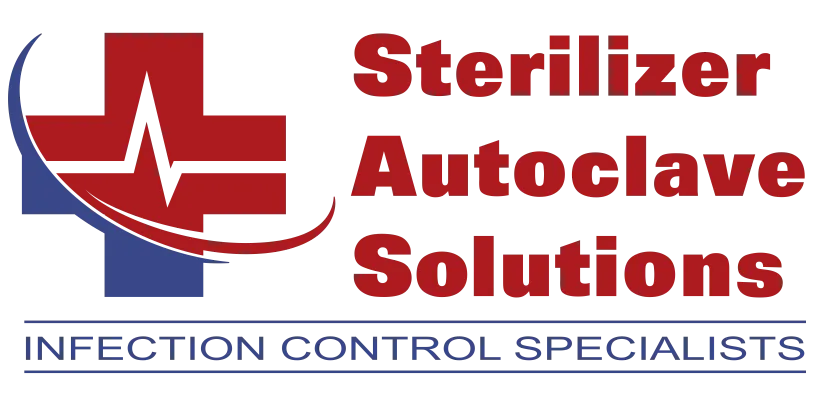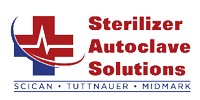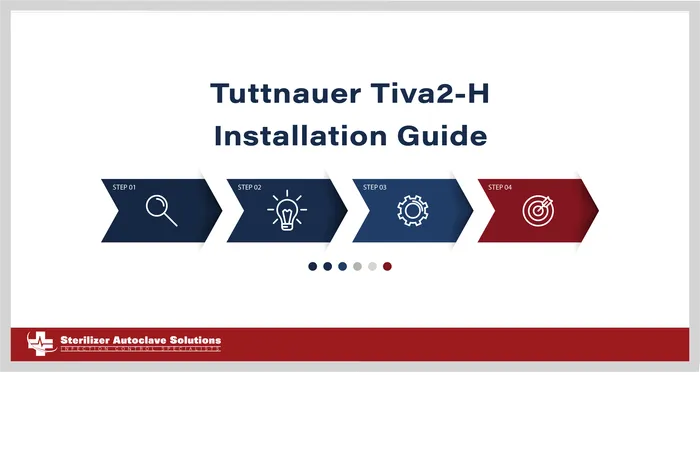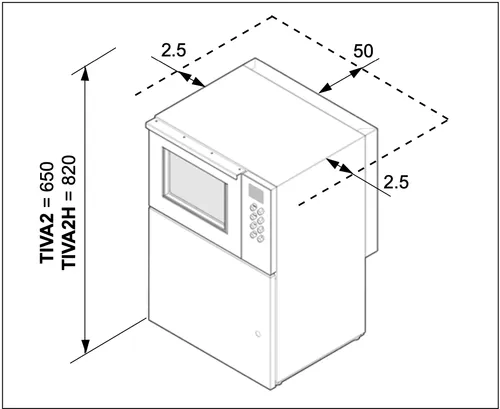Tuttnauer Tiva2-H Installation Guide
The Tuttnauer Tiva2-H is one of the best washer disinfectors currently on the market. With speed, power, and ease of use, this instrument washer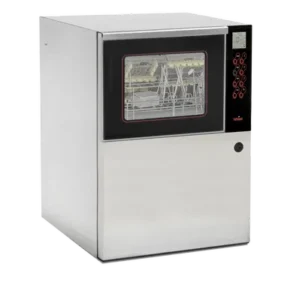 makes the perfect addition to your practice. When it comes to any sterilization technology, following the instructions is paramount to ensuring proper care. Even when it comes to the very start of the process, installation. And here at Sterilizer Autoclave Solutions, we make it our job to provide you with the proper knowledge to make sure everything goes smoothly. So in this article, we’d like to go over the installation instructions for the Tiva2-H instrument washer, with instructions provided by the manufacturer, Tuttnauer.
makes the perfect addition to your practice. When it comes to any sterilization technology, following the instructions is paramount to ensuring proper care. Even when it comes to the very start of the process, installation. And here at Sterilizer Autoclave Solutions, we make it our job to provide you with the proper knowledge to make sure everything goes smoothly. So in this article, we’d like to go over the installation instructions for the Tiva2-H instrument washer, with instructions provided by the manufacturer, Tuttnauer.
If you have any questions about the Tuttnauer Tiva2-H instrument washer or anything else, please give us a call at 704-966-1650 Option 3 for our Free Tech Support line.
Installation Guide
It is advisable that only furniture for professional use be positioned in the area around the machine, to avoid ruining them due to possible leakage of condensation water.
HAZARD: Do not install and/or use the thermodisinfector in environments with flammable/explosive atmosphere.
Make sure that the floor is fit to support the load of the equipment when in operation, equal to 70 Kg.
Unevenness of the machine surface and height can be adjusted with the four adjustable feet placed under the machine itself. There are two models of thermodisinfector (see Fig. 2):
The TIVA2 model is the classic model of thermodisinfector with small-sized product bowls, which can be positioned on any piece of furniture capable of withstanding its weight, within a dental practice.
The TIVA2H model is a thermodisinfector with much more capable product bowls than the TIVA2 version and which, usually, is embedded under a piece of furniture where appropriate space is already provided, within a dental practice.
HAZARD. All electrical and water connections (loading/ unloading) can only be carried out by specialized and authorized personnel and by consulting the relative diagrams.
Before machine positioning make sure that:
All the components needed for installation and proper use of the machine were installed: main switch, water supply taps, drain and anything else necessary. These components should have all the needed features and should be installed at the locations shown on the installation scheme.
WARNING: The use of unsuitable parts, and/or the implementation of installation procedures other than those shown on the installation diagram, will immediately void the machine warranty.
The characteristics of the electricity network must be compat- ible with the values required for correct operation indicated on the machine identification plate and on the technical data sheet.
The machine must be connected to an efficient earthing sys- tem (according to electrical safety standards).
The manufacturer is not to be held liable for any damage caused by improper earthing of the machine or faulty power supply.
Fig 7. – Minimum distance in mm
Built-in installation
The built-in machine can be inserted under a continuous work- top or under the sink’s drip surface. The recess niche must have a minimum space as shown in figure 7.
Electrical connection
HAZARD. Only qualified and experienced personnel can connect the machine to the mains supply, in compliance with the current laws and regulations.
WARNING: The main switch must be omnipolar circuit breaker, with adequate differential protection, positioned near the machine and not covered by machines or other that may hinder its use.
The magnetic-snap safety system, or the fuses, must be cali- brated according to the power indicated on the machine plate.
- Make sure that the measured voltage is equal to the one
- reported on the identification plate of the machine;
- Check that the voltage does not differ by more than 10% from its rated value;
- Make sure that the electrical system is equipped with an efficient earthing connection;
- Connect the cable installed on the machine to the three-phase plug (not supplied) and insert it into the interlocked socket
next to the machine. - The socket must be accessible after the machine installation. This facilitates verification of the electrical safety, e.g. in repair or maintenance interventions. The machine must be fed with current whose voltage, frequency and protection values correspond to those indicated on the data plate.
Electromagnetic compatibility (EMC)
The machine has been tested on electromagnetic compatibility (EMC) pursuant to Standard EN 61326-1 and is suitable for operation in institutes such as hospitals, medical practices, laboratories and environments connected to the public electricity grid.
The high-frequency (HF) energy emissions of the machine are so small that interferences with electrotechnical equipment in the immediate vicinity are not likely.
The optimal positioning floor must be made of concrete, wood or ceramic tiles. In case of machine operation on floors made of synthetic materials, the relative humidity must be 30% to minimize the likelihood of electrostatic discharges.
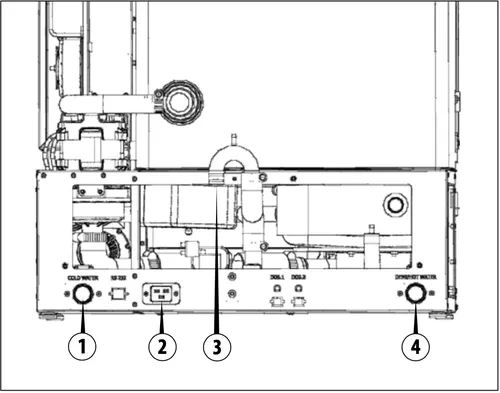
Fig. 8 – Connections (rear view of the machine)
1) Cold water connection.
2) Power supply socket.
3) Drain connection.
4) Cold or purified water connection (depending on the sales configuration).
Water connection
CAUTION: The water in the wash tank is not drinkable.
The quality of the water used must be compatible with the manufacturing materials of the machine, with the chemicals and with the process needs in the various stages of the procedure. To have good washing results, the water must be soft and low in limestone. With hard water white patinas deposit on the objects to be treated and on the walls of the wash tank.
Starting from a water hardness of 0.7 mmol/l (4 °dH) it is nec- essary to soften the water. Water hardness is set by technical assistance.
The water used should at least have the characteristics of drinking water according to the relevant European legislation in force. A high iron content can cause rust on the load and in the special washing and disinfecting machine. If industrial water contains a higher amount of chlorides than 100 mg/l, the risk of corrosion significantly increases.
The special washing and disinfecting machine is standard prepared for
connection to cold and purified water. Connect the flow pipes to the shut-off valves for cold or purified water.
The minimum flow pressure corresponds to the connection to cold water at 100 kPa in overpressure and in the connection to the purified water at 30 kPa in overpressure.
The recommended flow pressure in cold water connection is ≥ 200 kPa in overpressure and for purified water connection is ≥ 200 kPa in overpressure, to avoid long water flow times. The max. static water pressure allowed is 800 kPa in over-pressure.
The machine must be connected to the water mains in accordance with current regulations.
If the system upstream of the equipment has not been used for a long time, or if it is used for the first time, purge it by draining the water into a container or in a few minute drain in order to eliminate any impurities, air bubbles and/or anything else could damage the machine and obstruct its filers.
Connect the cold and purified(if available) water hoses, exiting the machine with their respective network connections, as shown on the installation diagram. It will be the responsibility of the installer to make sure that the temperature of the cold water supply is not higher than 5/15°C, otherwise proper washing of materials cannot be ensured. The connections for cold and purified water must not feed any equipment other than the instruments washer. During the washing cycle, this is necessary to prevent the subdivision of the water supply with other users, thus leading to a substantial increase in the time required to fill the tank (in this case an alarm will be triggered to alert the user that the maximum time allowed for water loading is exceeded).
If the machine is provided with a purified water feeding sys- tem but the plant is not equipped with it, the cold and purified water hoses should be connected together.
The machine can be equipped with a built-in softener, which has the function of reducing the scale in the water supplied
Connect the flexible hoses to the machine valves positioned in view at the back, making sure to connect them correctly based on the sales configuration.
Make sure to connect the water flexible hoses in the positions shown in figure 8.
Connect the cold water flexible hose to connection 1 in figure 8.
Connect the purified water flexible hose (if any), to connection 4 in figure 8.
WARNING. The flow pipes must not be shortened or damaged.
The water supply taps must be capable of quickly stopping the water line, therefore, they must be equipped with a ball or a gate valve. They must also withstand the operating pressure of the water, as indicated in the technical data sheet.
The installer must check the water hardness which must be 0.7 mmol/l (4 °dH). Possibly use a softener.
Water hardness conversion table
| Hardness expressed in French degrees (°fH) | Water hardness (mmol/l) | Hardness expressed in German degrees (°dH) |
|---|---|---|
| 0-10 | 0-1.01 | 0-5.60 |
| 11-15 | 111-1.51 | 6.16-8.40 |
| 16-20 | 1.61-2.02 | 8.96-11.20 |
| 21-25 | 2.12-2.52 | 11.76-14.00 |
| 26-30 | 2.62-3.03 | 14.56-16.80 |
| 31-35 | 3.13-3.53 | 17.36-19.60 |
| 36-40 | 3.64-4.04 | 20.16-22.40 |
| 41-45 | 4.14-4.55 | 22.96-25.20 |
| 46-50 | 4.65-5.05 | 25.76-28.00 |
| 51-55 | 5.15-5.56 | 28.56-30.80 |
| 56-60 | 5.66-6.06 | 31.36-33.60 |
Connection to the water drain
The machine is equipped with a built-in drain trap which must be mandatorily connected to the drain system of the building. The correct positioning and sizing of the drain trap are shown on the installation drawing. The user must carry out periodic maintenance of the drains and check that they are not clogged. Connect the grey drain pipe to the drain solenoid valve located at the back of the machine (3 Fig. 8).
WARNING. The manufacturer is not liable in case of environmental pollution due to an incorrect use of the thermodisinfector.
Filters, spray arms and regeneration rooms
Filters
Insert the supplied filters in the specific positions. Constantly check the cleanliness of the filters, especially the tank bottom filter (3 Fig. 9).
Use this filter to have a high filtering, taking into account that it will have to be cleaned after each cycle performed to avoid an excessive build-up of dirt.
Insert the mesh filter (2 Fig. 9) and place it in the tank seat. Finally, insert the central filter (1 Fig. 9) in the mesh filter hole.
Spray arms
The two spray arms are supplied loose to avoid possible breakage during transport. Place the two spray arms (top and bottom) in their seats and tighten them to the relative central pin inside the tank as shown in Fig. 10.
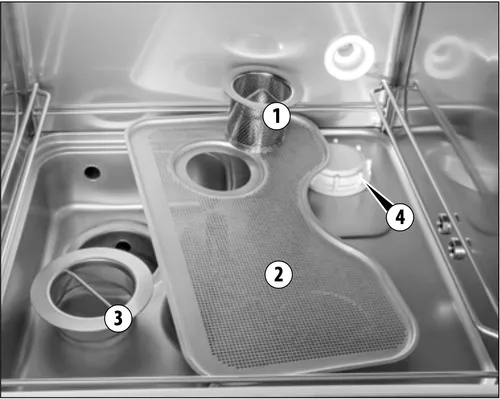
Fig. 9 – Filter unit
1) Central filter.
2) Mesh filter.
3) Tank bottom filter.
4) Salt tank cap.
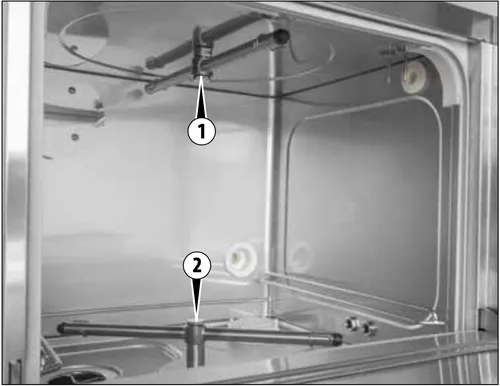
Fig. 10 – Spray arms
1.) Upper spray arm.
2.) Lower spray arm.
After fixing the spray arms, carry out a test by manually turning it, making sure that they rotate freely and without impediments.
After machine positioning, make sure nothing is pre- venting the tank door from being freely opened.
Make sure the machine is connected properly to the electrical supply, to the water supply and to the drain trap, then level it by adjusting its feet.
After installation remove the PVC protection layer covering the panels, make sure the liquid tanks are full and the suction nozzles are properly inserted into the right tanks. A label next to the cap indicates the type of liquid to be used for each suction tube.
Regeneration rooms
The Thermodisinfector is supplied without regeneration salt which will feed the device automatically during the regeneration process.
The salt must be introduced through the tank outlet inside the tank (4 Fig. 9). To introduce the salt, unscrew the cap (counter-clockwise) and fill the tank with salt, paying attention not to spread salt outside the bowl then close the tank with the cap. You must fill the salt tank every time the message “Refill salt” is displayed.
Use only appropriate coarse-grain salt.
Do not use kitchen salt, crushed salt tabs or other types different from those indicated, as it may contain insoluble substances.
Do not pour cleaning liquids or other solutions in the tank salt.
Failure to comply with these recommendations can lead to a malfunction of the water softening device. Just before the salt runs out completely, the display will show the message «Lack of salt». At this point, the salt should be topped-up as soon as possible, otherwise an error message will appear and it will no longer be possible to activate a new cycle if not by resetting.
Proceed as follows to refill the salt:
1) Delete the message on the display by pressing the RESET key for 5 seconds.
2) Open the door and remove any already inserted load.
3) Loosen the salt tank cap and insert the funnel.
4) In the first filling, introduce 1⁄2 liter of water to dissolve the residue salt. FIRST FILLING ONLY
5) Fill with salt up to the edge. The tank contains about 1 kg of salt.
6) Thoroughly clean the edge of the tank.
7) Tighten the cap again.
8) Start the «Rinse» cycle.
It is absolutely necessary to remove any salt residues that may have settled in the tank after refill and before rinsing.
After each top-up, start the «Rinse» program. In this way, any salt grains will dilute and rinse out. Salt residues and the overflowing water and salt solution can cause corrosion if they are not rinsed.
Following the instructions in the start-up paragraph, start the «Rinse» program.
Automatic regeneration
It is possible to have a water softening device that can completely regenerate at precise intervals. This process is fully automatic. Regeneration will be implemented before the selected program is activated.
This device must be preset by the technician during installation.
Regeneration can also be performed manually, regardless of the warning message on the display. To start, select the «Re- generation» program.
Chemicals
The dosing system for chemicals consists of:
Standard: A dosing pump for the standard detergent (a neutral or alkaline detergent is recommended).
Optional: A dosing pump for the neutralizer. This pump set on the acid neutralizing additive can also be used for dosing the rinse aid. In this case the installer must reset the device commands and modify the dosing pump.
TIVA2H: In the TIVA2H version it is possible to have three pumps for three different products.
Each dosing must is monitored by a dosing volume control. This electronic control checks the dosing amount. In the event of a lack of product, a message appears on the display and the program stops.
WARNING. It is recommended to handle the liquids with caution:
Protect eyes, hands, clothes and metal surface from contact with liquids, which contain partially irritating agents and caustic substances.
In case of contact with liquids, consult the instructions provided with the product.
Use only suitable liquids for cleaning and disinfection equipment. Carefully follow the manufacturer’s information.
Keep chemicals out of the reach of children and strangers. Possibly locked away.
Use on only Tuttnauer Europe b.v. approved products.
Do not use liquids for household dishwashers.
The liquid containers are positioned at the bottom of the machine, inside a door closed with a key (below). Open the lower door of the machine with the key.
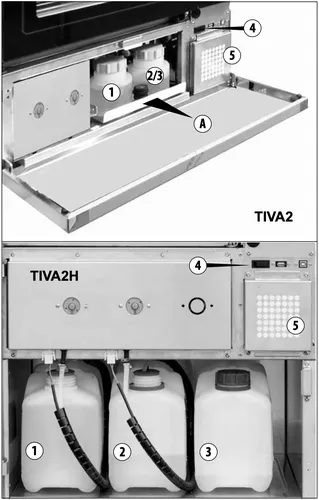
Fig. 11 – Product containers.
A) Drawer extraction direction.
1) DOS1 detergent liquid container.
2) DOS2 rinsing liquid containers.
3) DOS3 Neutralising liquid container.
4) ON-OFF switch.
5) Air suction filter.
Refill procedure
For the TIVA2 thermodisinfector:
- Pull and extract the drawer manually (A Fig. 11);
- Loosen the cap with container 1 tube (or 2/3);
- Fill the container with the related chemicals.
- «Detergent»
- «Neutraliser / Rinse aid».
- Tighten the cap well and put the drawer back in its position.
For TIVA2H thermodisinfector:
- Set up a new tank with the chemical;
- Extract the empty tank 1 or 2 or 3 (Fig. 11);
- Remove the tube and place it on a non delicate and easy to clean surface;
- Insert the tube in the relative tank and put it back in the corresponding position:«Detergent»
- «Neutraliser»
- «Rinse aid».
- At the end, close the front door with the key.
- Start the program «Fill DOS1» for the detergent or «Fill DOS2» or «DOS3» for the neutralizer or rinse aid.
Be careful not to reverse the position of the liquids.
Failure to follow these recommendations may damage the thermodisinfector.
With regard to the maximum dosage for each program, follow the instructions of the chemical manufacturer.
- To ensure efficiency of the dosing system, it is necessary to regularly carry out the maintenance operations set out in the «Maintenance» chapter.
- The indications concerning the storage and disposal of chemical substances are provided by the respective manufacturers and must be observed.
- Do not place the chemical containers on the thermodisinfector.
- Completely empty the thermodisinfector before performing maintenance and before moving the machine to avoid contact with the chemicals and to protect the machine components.
Using and storing chemicals
Keep the containers tightly closed, stored in a dry place and protected from the sun, out of reach of children and strangers. Possibly locked away. Optimal storage temperature: from +0° to +25°C. The shelf life in the original containers is indicated on the chemicals’ labels. Tuttnauer Europe b.v. recommends a method for inventory management (First In – First Out). The Tiva thermodisinfector has a standard of two pumps for dosing the detergent and rinsing liquids.
Tuttnauer Europe b.v. recommends using cleaning agents and chemical additives. The use of other products can dam- age the machine.
The flowmeters of chemical are calibrated according to the density of these tested products which ensure cor- rect operation. Liquids recommended by Tuttnauer Eu- rope b.v.:
- DOS1: MEDI CLEAN DENTAL (Neo Disher);
- DOS2: Z DENTAL (Neo Disher);
- DOS3: MEDI KLAR DENTAL (Neo Disher).
When chemical disinfectant levels are low, a warning message appears on the display.
Chemical products dosing is set to an average value as recommended by the manufacturer.
When the actual dosing of the chemical disinfectant exceeds the tolerance of 5%, the system goes into alarm.
If these recommended liquids are not used in the ma- chine, the flow meters must be calibrated for the new liquids.
WARNING: ONLY USE LIQUID CHEMICALS. THE MACHINE CANNOT WORK WITH POWDER DETERGENTS
As always if you have any questions about this process or anything else please feel free to contact us and take advantage of our “FREE TECH SUPPORT.”
We also offer FREE VIRTUAL TECH SUPPORT to “See and Talk” with a “Real Time Live Technician” for any problems you may be in need of help with.
You can also use our “FREE MAINTENANCE PROGRAM”. Take the guesswork and worrying about what unit is due for maintenance and which maintenance cycle it is time for. We will keep track of all your autoclaves and let you know when it’s time for anything.
The Tuttnauer Tiva2-H instrument washer is available here on our website.
The Tuttnauer Tiva2-H Operation Guide is able to be viewed on our website here
